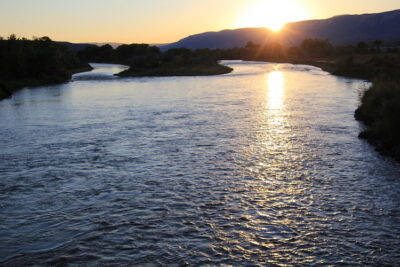
The North Fork Valley. Image courtesy of KVNF Public Radio
Representatives of the agricultural interests in our neighboring North Fork Valley made a trip to Washington, D.C. this past week, where they made an appeal for rural climate and conservation action. The annual trip takes on added importance this year as Congress takes up the 2023 Farm Bill and federal agencies are considering actions to manage public lands and address global warming,
The group from Delta and Gunnison County met with Sen. Michael Bennet, the office of Sen. John Hickenlooper, the U.S. Bureau of Land Management, the White House Council on Environmental Quality, and Colorado congressional offices. It made the case not just for the North Fork Valley but on behalf of the agricultural interests of Colorado, for protecting the lands, water, wildlife, and rural economy of the region by addressing climate change and acting to protect and restore public lands and regional watershed health.

North Fork Valley delegation on the steps of the U.S. Capitol. Courtesy photo.
“The Farm Bill is one of several key opportunities to build on historic steps taken by Congress and this administration in 2022,” said Pete Kolbenschlag with Colorado Farm & Food Alliance, one of three groups who lead the annual trip. “It is time to put farmers, ranchers and rural communities front and center as valued partners in addressing the climate emergency.”
The genesis of the North Fork Fly-In goes back to 2012, when the Valley was challenging an oil and gas lease sale that many feared would jeopardize this agricultural jewel’s vital water source areas and supplies. That challenge was ultimately successful.
But many of the public lands in the area, as well in other areas across Colorado, remain under-protected, and at risk from both fracking and development schemes.
“We learned that the Interior Department and BLM were launching a rulemaking to rebalance how our public lands – and the vital ecological services they provide – are maintained and not degraded,” said Western Slope Conservation Center Public Lands Program Director Ben Katz.
“The Bureau of Land Management has listened to communities like ours … these lands are water source areas for our farms and downstream Americans, and vital for the wildlife that depends on them as calving areas, migration corridors, and critical habitat,” said Katz.

The sun setting on the Colorado River at Silt. Photo by Allen Best.
The group pointed out that the Gunnison River Basin, of which the North Fork watershed is a critical piece, produces the second largest tributary to the Colorado River system, upon which tens of millions depend. The delegation urged Colorado’s elected leaders to work together to protect the lands and watersheds critical to our future in the U.S. Southwest.
Last year’s historic funding for climate change with the passage of the Inflation Reduction Act and the Bipartisan Infrastructure Law directly benefit rural communities. As with other high mountain Colorado counties, the North Fork delegation, concerns have focused on the tenuous nature of the water supply to secure the valley’s lands, farms and food systems.
“Making it easier for community-led projects to get funding for restoration can make all the difference to managing these headwaters areas,” said watershed expert Jake Hartter, a small business owner and member of the North Fork delegation. “Functioning wetlands can act as a ‘second snowpack’ releasing water slowly over the summer, and not all at once when we get a fast snowmelt.”
The group emphasized the need to manage these lands along ecological boundaries, not just political and map boundaries like county lines.
“I moved back to our family farm from L.A. because I was ready for clean air and clean water,” said Kori Stanton, a lavender farmer, filmmaker and community delegate.
“I also sit on the board of Citizens for a Healthy Community, an organization working to protect our watershed from oil and gas activity,” she added. “The water, the air, the wildlife don’t stop at the county line. I know firsthand what is at stake, and it’s as real as the threat to the already fragile landscape, to the water and ditches, that new industrial activity poses to our valley’s farms. The North Fork should be managed as a single watershed, with its cumulative and long-term health in mind.”
A recent climate report prepared by the Colorado Farm & Food Alliance stressed the willingness of rural Colorado to act to address climate change. But — this requires government partnerships with rural communities and recognition of the importance of the nation’s headwaters here in the Rocky Mountains to both local and national food security.
Every five years, Congress reauthorizes the Farm Bill. It provides important funding for farmers, rural communities, and food security including the food assistance SNAP program, funding to protect our forests, community-based rural renewables, and land and watershed health initiatives.
“Federal funding to support conservation practices on family farms is a critical piece of making our food and water supplies more resilient,” said Matt Springer, representing the Valley Organic Growers Association, the third group leading the trip. “Protecting the water supply, promoting soil health, and strengthening the local food system: These are all places where federal policy can make a difference, we can boost climate resilience, increase food security, and help our farmers too.”








Recent Comments